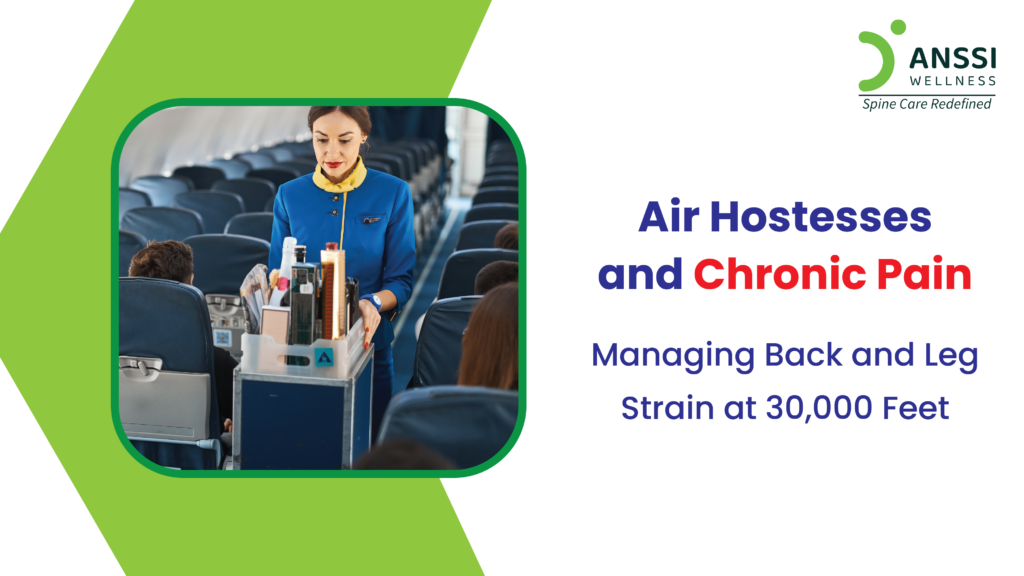Being an air hostess is a glamorous yet physically demanding profession. Long hours on their feet, lifting heavy luggage, and dealing with turbulence put immense strain on their backs and legs. Over time, these stressors can lead to chronic pain, affecting both job performance and overall well-being.
Understanding the causes of pain and adopting effective management strategies can help air hostesses maintain their health and continue their careers pain-free.
The Hidden Struggles of Air Hostesses
For an air hostess, the following conditions offer unique physical challenges.
Prolonged Standing and Spinal Strain
Air hostesses spend most of their shifts standing or walking in the narrow aisles of an aircraft. Unlike office workers who can sit down regularly, air hostesses remain on their feet for extended periods, serving passengers and ensuring in-flight safety.
Impact:
- Standing for too long puts pressure on the lower back and knees.
- It reduces blood circulation, leading to leg swelling and varicose veins.
- It increases the risk of developing conditions like sciatica and lower back pain.
Lifting Heavy Luggage
Helping passengers stow their luggage in overhead compartments is a routine but risky part of the job. Air hostesses repeatedly lift and move around heavy bags, often twisting their bodies in awkward positions due to limited space.
Impact:
- Lifting improperly strains the spine, shoulders, and wrists.
- Repeated lifting can cause herniated discs, muscle sprains, and joint pain.
- Poor posture while handling luggage increases the risk of long-term spinal issues.
Turbulence and Sudden Movements
Turbulence is unpredictable and often requires sudden physical adjustments to maintain balance. Air hostesses are particularly vulnerable since they are frequently moving around the cabin while passengers are seated.
Impact:
- Sudden jerks can strain back and leg muscles.
- Risk of falling or hitting hard surfaces, leading to injuries.
- Repetitive exposure to turbulence-related strain can lead to chronic pain conditions.
Managing Back and Leg Strain Effectively
While the job presents physical challenges, there are ways to reduce and manage pain. Adopting healthy habits can make a significant difference in spine and leg health.
Stretching and Strengthening Exercises
Regular stretching helps maintain flexibility and prevents muscle stiffness, while strength training stabilises the spine and reduces pain.
Pre-flight and Post-flight Stretches:
- Lower Back Stretch: Sit and reach for your toes to relieve spinal tension.
- Calf Stretch: Stand against a wall and stretch your calves to improve circulation.
- Shoulder Rolls: To relieve stress, roll your shoulders forward and backwards.
Strength Training Recommendations:
- Core-strengthening exercises like planks help support the lower back.
- Leg workouts, such as squats, strengthen muscles and improve endurance.
- Resistance band exercises can help with flexibility and balance.
Choosing the Right Footwear
Wearing the right shoes is crucial in preventing foot, knee, and back pain. High heels may be part of the uniform, but they can be harmful if worn for long periods.
Tips for Better Footwear Choices:
- Opt for low-heeled, cushioned shoes when possible.
- Use gel insoles or orthopaedic inserts for added support.
- Alternate between different pairs of shoes to avoid repetitive strain.
- When off duty, wear comfortable, well-supported shoes to allow recovery.
Practicing Proper Lifting Techniques
Reducing the risk of injury while handling luggage requires proper body mechanics.
Safe Lifting Tips:
- Always bend your knees instead of bending at the waist.
- Keep your back straight and engage your core when lifting.
- Hold luggage close to your body to reduce spinal strain.
- When possible, ask for assistance from colleagues or passengers.
Hydration and Nutrition for Spinal Health
A balanced diet helps maintain strong bones and muscles, reducing the risk of chronic pain.
Nutritional Tips:
- Drink plenty of water to keep spinal discs hydrated.
- Eat calcium-rich foods (dairy, leafy greens) for bone strength.
- Include magnesium-rich foods (nuts, seeds) to prevent muscle cramps.
- Consume anti-inflammatory foods (turmeric, salmon) to ease joint pain.
Spine-Friendly Treatments
For air hostesses already experiencing chronic back pain, a number of non-surgical treatments can be effective. For example, spinal decompression is an advanced treatment that gently stretches the spine, relieving pressure on discs and nerves to promote healing without surgery or injections.
Benefits of Non-Surgical Spinal Decompression:
- Reduces chronic lower back pain.
- Improves spinal alignment and flexibility.
- Increases blood flow to spinal discs for faster healing.
- Provides long-term relief without medication.
Recovery and Self-Care
Taking care of the body after long flights is essential to prevent chronic pain.
Post-Flight Recovery Tips:
- Soak feet in warm water with Epsom salt to reduce swelling.
- Use a foam roller or massage therapy to release muscle tension.
- Apply heat or ice packs to sore areas for pain relief.
About ANSSI:
ANSSI Wellness focuses on improving the quality of life for patients suffering from spinal issues, aiming to provide relief where other conventional treatments have failed. Through advanced non-surgical spinal decompression treatment, ANSSI is committed to helping patients avoid surgery and recover in a safe, effective, and compassionate environment.
Connect with ANSSI Wellness on LinkedIn, Instagram, and Facebook for expert guidance.



